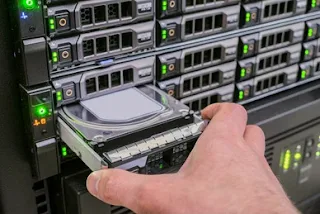RAID stands for "redundant array of inexpensive disks" or "redundant array of independent disks". RAID is a type of data storage virtualization technology that writes data across several disk drives present in the same unit, to improve performance and data redundancy. The disk drives are combined into one unit, as if it were a more expensive disk, with more speed and durability, by storing data in all drives rather than specific ones.
RAID, which stands for Redundant Array of Independent Disks, is a data storage technology that combines multiple physical disk drives into a single logical unit. The primary goal of RAID is to improve data reliability, performance, and storage capacity. In this article, we will explore the intricacies of RAID, its various levels, benefits, and applications in modern computing systems.
Grasping the Concept of RAID
Raid technology was first introduced in the 1980s as a response to the limitations of single disk storage systems. RAID utilizes a technique called disk striping, which distributes data across multiple drives to achieve better performance and fault tolerance. Here are some key aspects to understand about RAID:
RAID Terminology and Concepts
Before delving deeper into RAID levels, it's important to grasp the fundamental terminology and concepts associated with RAID. From disks and arrays to mirroring and parity, this section will cover the essential building blocks of RAID technology.
RAID Levels Explained
RAID offers several levels, each with its own characteristics, advantages, and trade-offs. We will explore the most common RAID levels, including RAID 0, RAID 1, RAID 5, RAID 6, RAID 10, and RAID 50. This section will provide a comprehensive overview of each level, highlighting their unique features and use cases.
Benefits of RAID
Implementing RAID technology brings numerous benefits to data storage systems. From improved data redundancy and fault tolerance to enhanced performance and scalability, this section will delve into the advantages that RAID offers to organizations and individuals.
RAID Applications
RAID finds application in various computing environments, from personal computers to enterprise-level storage systems. This section will discuss the diverse use cases of RAID, such as database servers, video editing workstations, and network-attached storage (NAS) devices.
Choosing the Right RAID Configuration
Selecting the appropriate RAID configuration depends on several factors, including the intended use, performance requirements, and desired level of data protection. This section will guide you through the considerations involved in choosing the right RAID level for your specific needs.
Implementing RAID
Implementing RAID involves configuring the drives, setting up the necessary hardware or software components, and managing the RAID array. This section will provide a step-by-step guide on how to implement RAID in different scenarios, covering both hardware and software RAID setups.
RAID and Data Recovery
While RAID offers improved data reliability, it is not immune to failures. In the event of drive failures or data corruption, it's crucial to have a solid data recovery plan in place. This section will discuss data recovery strategies specific to RAID configurations.
RAID Beyond Traditional Hard Drives
RAID technology has expanded beyond traditional hard drives to include solid-state drives (SSDs) and other storage media. This section will explore the considerations and benefits of implementing RAID with SSDs and other emerging storage technologies.
As technology continues to advance, the future of RAID holds exciting possibilities. This section will discuss emerging trends, such as software-defined storage and cloud-based RAID, and their potential impact on data storage and management.
RAID technology has revolutionized the way we store and protect data. By combining multiple disks into a single logical unit, RAID provides improved performance, reliability, and scalability. Whether it's for personal use or enterprise-level storage, understanding RAID and its various configurations is essential for maximizing data efficiency and protection.

